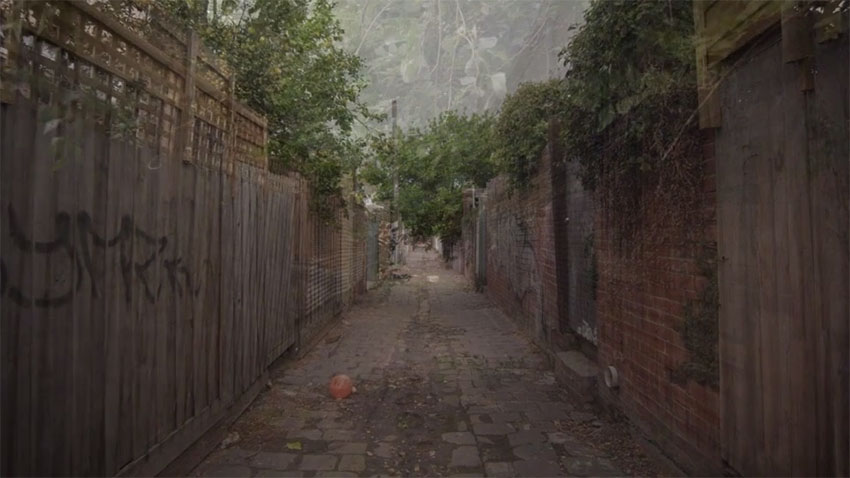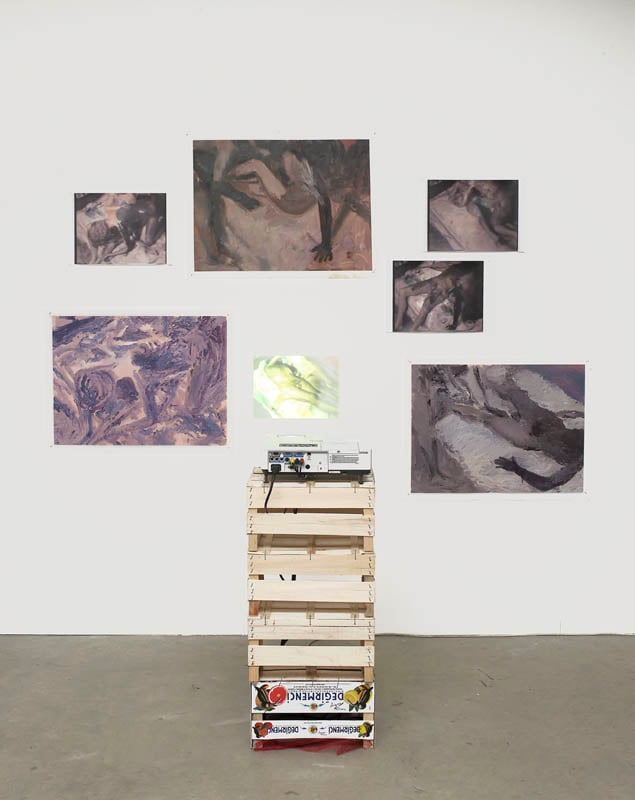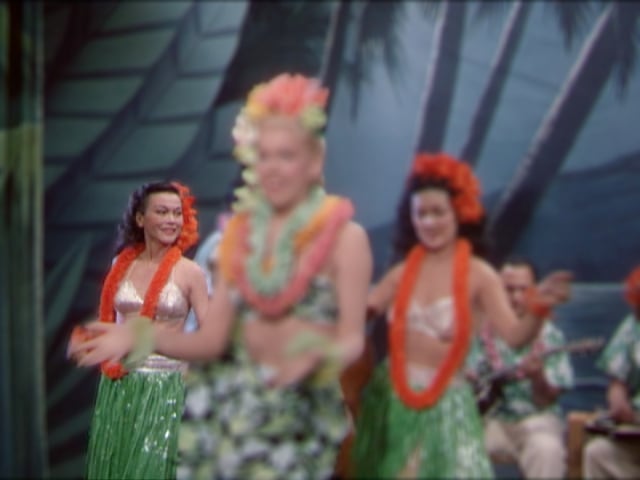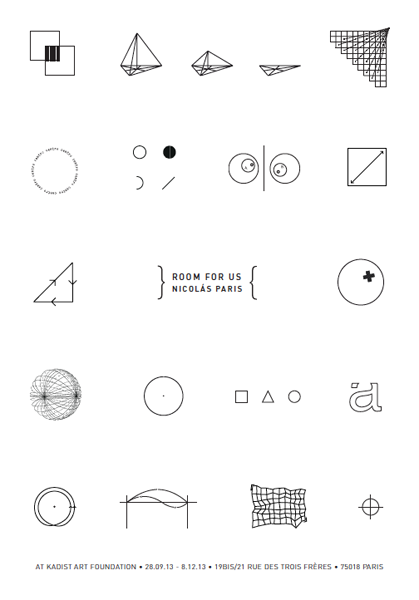
© » KADIST
Anna Boghiguian
In the painting called “The Consciousness of Memory, Time, and Guilt” as in many of her recent works, the body is fragmented. The brain, the ear, the eyes, these body parts that put us in relation with the other and link the visible to the invisible, remain isolated. Whereas the skulls are joined by lines evoking rivers.

© » KADIST
Nicholas Buffon
A series of works from 2016 document his neighborhood, replicating buildings and businesses he frequents within four blocks of his New York apartment. Made out of foam, paper, glue, and paint, these miniaturized buildings (a bank, a bar, a Laundromat, and the Rite Aid building where Buffon shops) impart a tenderness and a nostalgia that outsizes their diminutive scale. Like works by other artists who recreate objects or elements from their everyday life, Buffon’s storefronts are perfectly imperfect, the wobbled lines reiterating their handmade quality.

© » KADIST
Ei Arakawa and Sergei Tcherepnin
Part of a series entitled “Looking at Listening”, 2011, the piece invited the spectator to experiment and consider sound as a kinetic and synesthetic process, where multiple experiences and senses can cross. The presented photographs were selected from the New York Public Library and found in an archive called ‘Listening,’ with the sub-genres ‘town meetings,’ ‘investigation,’ ‘audiences 1960–1970’ and ‘conversation.’ Taking the photographs from the city’s archive of frozen moments of audio exchange, Arakawa and Tcherepnin give sound and movement back to past moments. In each of the photographs, people are listening in different situations—public, and private.

© » KADIST
Carter Mull
Mull’s Worker’s Clock collage works bring together images from the artist’s studio photography practice, found photographs, and pages from a phone book, laying them over a psychedelic warp of color in the background. One of the images is borrowed from a billboard, Double Block (for Alanna Pearl, Nik Nova and R. Mutt) (2013) that Mull created to hang above some storefronts in downtown Los Angeles. The pair of photographs features a woman posed in the center for rings of numbers, her body and shadow taking the place of the mechanical hands.

© » KADIST
Euan Macdonald
The video 9000 PIECES by Euan Macdonald was filmed at a musical instrument factory in Shanghai where 90 percent of the pianos that they manufacture are exported around the world, and only 10 percent are “finished” and can be labeled “Made in the US (or) Europe.” The video captures an intricate network of mechanisms as they interact with each other, their rhythmic movements resulting in an intense choreography and a cacophony of metallic sounds dramatized by Macdonald’s editing. As the shot widens it reveals the process we see unfold: a piano being vigorously tested by a factory machine designed to determine the endurance of the instruments. Contrary to what is often relayed, the work has nothing to do with Chinese factories or fast changing global economies.

© » KADIST
Felix Gmelin
In Untitled (after Paul Schultze Nuremberg’s Kunst) (2006), from a larger series of diptychs, Gmelin addresses the notion of entartete kunst ( “Degenerate Art”) . Each diptych juxtaposes a portrait of a person considered to be mentally handicapped with a painting that was branded by the Nazi regime as degenerate. Gmelin’s source for these images is Kunst und Rasse (“Art and Race”), a book by Paul Schultze Naumburg published in 1928.

© » KADIST
Markus Amm
A combination of planning and improvisation, control and lack of control, this painting is typical of Amm’s work. With its intimations of the sublime and reference to the works of Ad Reinhardt and Mark Rothko this painting extends the Romantic and modernist traditions in a perceptive way. These are subtle, slow, delicate paintings that evolve over a period of time—the product of long periods of contemplation.

© » KADIST
Miljohn Ruperto
Miljohn Ruperto’s high-definition video Janus takes its name from the two-faced Roman god of duality and transitions, of beginnings and endings, gates and doorways. He is usually depicted with two faces as he looks both forward and backward, to the future and the past. The video, which is deftly animated in collaboration with Aimée de Jongh, presents a close-up of a dying “duck-rabbit,” a vivified version of an ambiguous illustration made popular by the Austrian-British philosopher Ludwig Wittgenstein in his Philosophical Investigations .

© » KADIST
Daniel Crooks
The Illusion of Everything (2014) follows an unseen pedestrian as he navigates the Australian city of Melbourne’s dense and intricate network of laneways. The video begins with the pedestrian traversing a seemingly idyllic ivy lined stone and concrete thoroughfare. As his pace begins to accelerate, the camera follows him with greater urgency, slowly settling and become stable again as his pace decelerates.

© » KADIST
Richard T. Walker
let this be us is a single-channel video by Richard T. Walker featuring the artist himself roaming around the wilderness of a deserted landscape, sporadically humming a melody, strumming a guitar, or playing a few notes on a keyboard. As he traverses between striking locations we see him carrying large photographic prints of the same landscape that he is treading, which he then rests onto tripods so that the horizon in the photograph seamlessly matches that of the real landscape. As we hear the music, Walker comes in and out of view, dissipating into the landscape as his body becomes invisible, hidden behind the photographic prints.

© » KADIST
Hiraki Sawa
Hako (2006) depicts a mysterious and dystopic landscape where the world becomes flat: distance between different spaces, depth of field and three-dimensional perceptions are canceled. Interiors of a Victorian doll’s house, a rippled seascape, a palm tree forest, and a gravel seashore are superimposed, morphing into each other. The hermetic narrative is charged with psychological and mythological aspects.

© » KADIST
Rodney Graham
Tree on the Former Site of Camera Obscura (1996) belongs to a series of large-scale photographs of trees taken by Graham and depicts a particular species that lives in Northern California. The photograph is framed upside down; these “inverted trees” follow Graham’s early experiments with the camera lucida, a room-size pinhole camera that dates back to ancient times. Through these works Graham looks back at the history of photography while making the viewer aware of his or her own retinal experience.
Daniel Crooks
- year born: 1973
- gender: male
- nationality: New Zealander
- home town: Hastings, New Zealand
Markus Amm
Markus Amm studied graphic design at the Hochschule für Gestaltung in Offenbach, Germany...
Hiraki Sawa
- location: London, United Kingdom
- year born: 1977
- gender: male
- nationality: Japanese
- home town: Ishikawa, Japan
Ei Arakawa and Sergei Tcherepnin
Ei Arakawa and Sergei Tcherepnin began their audio-visual and performative collaboration in 2007...
Maaike Schoorel
Based on photographs and domestic environments, Maaike Schoorel’s paintings are charged with an atmosphere of melancholy and loss...
Mateo Lopez
- location: Bogota, Colombia
- year born: 1978
- gender: male
- nationality: Colombian
- home town: Bogota, Colombia
Euan Macdonald
Euan Macdonald’s videos, drawings and sculptures are informed by a wide array of philosophical, musical, and literary references, but return repeatedly to the quotidian occurrence, the everyday as subject...
Felix Gmelin
With a degree in painting and inspired by so-called institutional criticism, Felix Gmelin is interested in the possibilities of painting as a form of resistance and its direct relation to a form of socio-political reality...
Anna Boghiguian
Anna Boghighian makes drawings and paintings of individuals and urban spaces as well as being a writer and a poet...
Richard T. Walker
- location: San Francisco, California
- year born: 1977
- gender: male
- nationality: British
Nicholas Buffon
Working in paint, performance, and small, diorama-like wall sculptures, Seattle transplant Nicholas Buffon responds to his context through intimate gestures, examinations, and recreations...
Miljohn Ruperto
- location: Los Angeles, California
- year born: 1973
- gender: male
- nationality: Filipino and Danish
- home town: Manila, Philippines
Carter Mull
Los Angeles-based artist Carter Mull is an obsessive sort, and his fascinations show through in his multimedia photographic and installation-based works...
Rodney Graham
- location: Vancouver, Canada
- year born: 1949
- gender: male
- nationality: Canadian
- home town: Vancouver, Canada
-
1990-1999
Rodney Graham
1996Tree on the Former Site of Camera Obscura (1996) belongs to a series of large-scale photographs of trees taken by Graham and depicts a particular species that lives in Northern California...
-
2000-2009
Felix Gmelin
2006In Untitled (after Paul Schultze Nuremberg’s Kunst) (2006), from a larger series of diptychs, Gmelin addresses the notion of entartete kunst ( “Degenerate Art”) ...
Hiraki Sawa
2006Hako (2006) depicts a mysterious and dystopic landscape where the world becomes flat: distance between different spaces, depth of field and three-dimensional perceptions are canceled...
-
2010-2019
Euan Macdonald
2010The video 9000 PIECES by Euan Macdonald was filmed at a musical instrument factory in Shanghai where 90 percent of the pianos that they manufacture are exported around the world, and only 10 percent are “finished” and can be labeled “Made in the US (or) Europe.” The video captures an intricate network of mechanisms as they interact with each other, their rhythmic movements resulting in an intense choreography and a cacophony of metallic sounds dramatized by Macdonald’s editing...
Ei Arakawa and Sergei Tcherepnin
2011Part of a series entitled “Looking at Listening”, 2011, the piece invited the spectator to experiment and consider sound as a kinetic and synesthetic process, where multiple experiences and senses can cross...
Carter Mull
2013Mull’s Worker’s Clock collage works bring together images from the artist’s studio photography practice, found photographs, and pages from a phone book, laying them over a psychedelic warp of color in the background...
Miljohn Ruperto
2013Miljohn Ruperto’s high-definition video Janus takes its name from the two-faced Roman god of duality and transitions, of beginnings and endings, gates and doorways...
Anna Boghiguian
2014In the painting called “The Consciousness of Memory, Time, and Guilt” as in many of her recent works, the body is fragmented...
Daniel Crooks
2014The Illusion of Everything (2014) follows an unseen pedestrian as he navigates the Australian city of Melbourne’s dense and intricate network of laneways...
Nicholas Buffon
2016A series of works from 2016 document his neighborhood, replicating buildings and businesses he frequents within four blocks of his New York apartment...
Markus Amm
2017A combination of planning and improvisation, control and lack of control, this painting is typical of Amm’s work...






